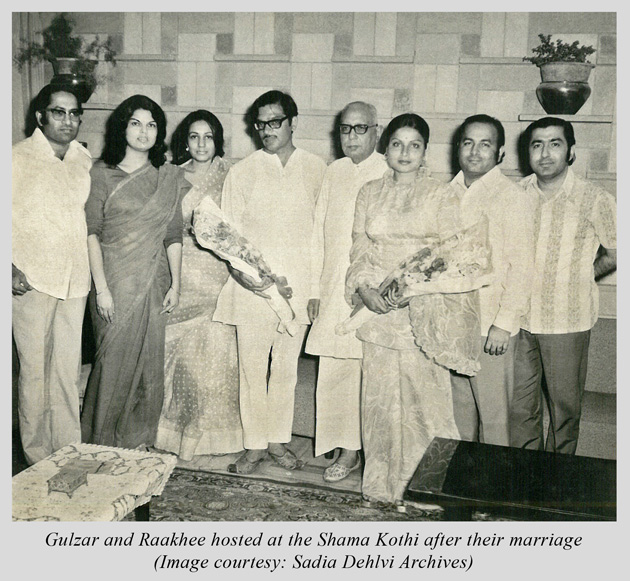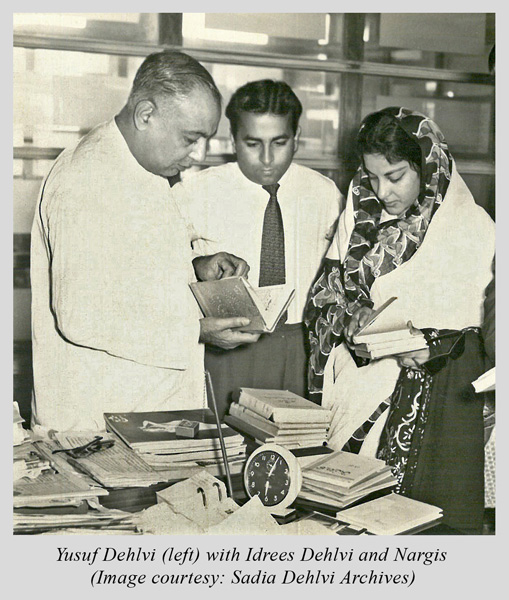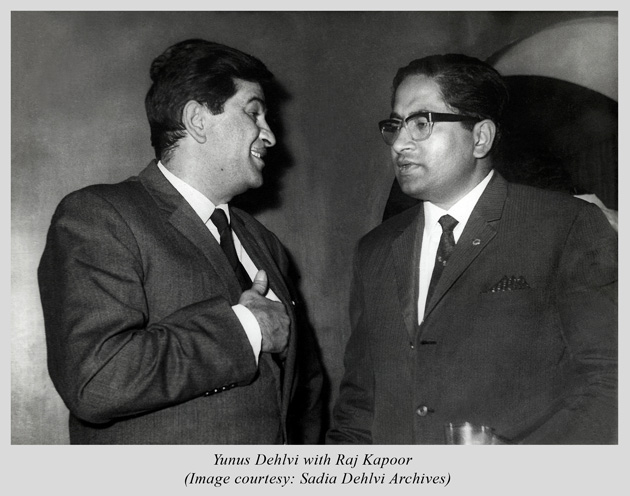
The Golden AgeBY YASIR ABBASI 1 Shama Film Magazine Shama Urdu Magazine Yusuf Dehlvi
Once, Urdu film magazines were plentiful, each with loyal readerships. But Shama was the best, writes Yasir Abbasi, as he traces the demise of a culture
“It is to Shama’s credit [that it]
singlehandedly spread… fondness for Urdu
throughout the world. I have personally
witnessed people travelling miles to buy
Shama in Europe”—Kamal Amrohi, film director and writer
The present generation might be unaware of it but there was a time—and a fairly long one at that—when the fame of Urdu film magazine Shama was spread across India and the Urdu-reading diaspora around the world. In 1954, it became the first Urdu magazine in the subcontinent to hit a circulation of 1,00,000 copies a month. Its dominance was so absolute that in the spirit of solidarity it carried advertisements for other Urdu film periodicals within its pages, including those of its closest rival, Ruby.
Urdu film journalism, which had begun in the mid-1920s, arguably arrived as a craft in 1934 with the Lahore-based Chitra. The advent of talkies had caused much excitement in the country and slowly but surely the prejudice against cinema as a lowly occupation was wearing off. Lahore was a major centre of filmmaking at the time and it was also home to The Cinema, a much respected English-language monthly edited by Bodh Raj Oberai, who B R Chopra once referred to as the “fountainhead of film journalism”.

Yusuf Dehlvi, a successful Delhi businessman dealing in real estate and leather, launched Shama in September 1939. Following the template of Chitra and other Urdu film magazines, the content was a combination of film and literary writing. Priced at two annas a copy, the first issue carried a couplet on its cover:
Lo shama hui raushan, aane lage parwaane,
Aaghaaz jab aisa hai, anjaam khuda jaane
The magazine was perhaps not instantly successful, but it soon became credible, a worthy addition to the scene. Dehlvi, too, was a steadfast proprietor, funding the magazine through the tumult of Partition and through the looting of his warehouse.
By the early 1940s, the likes of Master Nisar, Master Vithal, Sulochana and Sabita Devi were past their prime and had made way for newer stars such as Motilal, Ashok Kumar, Noor Jehan and Naseem. And, around Independence, Nargis, Madhubala and the troika of Dilip, Raj and Dev (Kumar, Kapoor and Anand, of course) were on the cusp of their eventually legendary fame. An already star-struck India was moving into an era of ever more fervent hero worship. As the magazines provided access and insight into these dazzling stars, the popularity of titles such as Shama skyrocketed.
Partition also led to the influx of a sizeable population of Urdu readers in India from what was now the other side of the border. Urdu, which had been somewhat neglected, marginalised, suddenly seemed to have a new energy, a new lease of life. These readers pushed Shama to the top, rewarding Dehlvi’s persistence.


The mix in these magazines was intoxicating, giving readers a variety of pieces, treating both cinema and literature as high culture but without stultifying reverence. Shama was a lively publication; its readers could expect top quality and a commitment to maintaining those standards. Among the regular contributors were top-of-the-line fiction writers like Rajinder Singh Bedi, Ismat Chughtai and Krishan Chander, not to mention celebrated poets like Jigar Moradabadi and Firaq Gorakhpuri. It was said at the time that one wasn’t a writer of genuine merit until one’s byline had appeared in Shama. The magazine’s stature can be gauged by the fact that regular film columnists included such award-winning names as Khwaja Ahmad Abbas and Rahi Masoom Raza. Even conservative Urdu-speaking households that would not ordinarily sully their doors with such frivolities as film magazines would make an exception for Shama.

Yusuf Dehlvi had st arted Shama, and for a while it was essentially a one-man operation. As it became increasingly successful, his three sons—Yunus, Idrees and Ilyas—joined him at work. Buoyed by Shama, the family launched a number of other periodicals, including Khilona, Bano and Shabistaan targeting specific readers, women, say, or children. Each of these titles, too, went on to acquire cult status, if not quite the mass following of Shama. In a time when low pay (or just as often no pay) was synonymous with Urdu periodicals, Shama paid its writers well. Dehlvi and family also moved into publishing, commissioning novels for the newly created Shama Book Depot. Some writers, like Wajida Tabassum, arguably owe their careers to the initial interest created by being ‘discovered’ by Shama’s publishing arm. The family dabbled briefly in filmmaking too, setting up a firm called Shama Distributors and financing such films as Ghar Sansar (1958) and Batwara (1961).
arted Shama, and for a while it was essentially a one-man operation. As it became increasingly successful, his three sons—Yunus, Idrees and Ilyas—joined him at work. Buoyed by Shama, the family launched a number of other periodicals, including Khilona, Bano and Shabistaan targeting specific readers, women, say, or children. Each of these titles, too, went on to acquire cult status, if not quite the mass following of Shama. In a time when low pay (or just as often no pay) was synonymous with Urdu periodicals, Shama paid its writers well. Dehlvi and family also moved into publishing, commissioning novels for the newly created Shama Book Depot. Some writers, like Wajida Tabassum, arguably owe their careers to the initial interest created by being ‘discovered’ by Shama’s publishing arm. The family dabbled briefly in filmmaking too, setting up a firm called Shama Distributors and financing such films as Ghar Sansar (1958) and Batwara (1961).
Shama remained the flagship product of the group. In its August 1985 issue, actor Dharmendra says, “I’ve been diligently reading Shama since the time I was studying in the 9th standard. I remember I had to go to the Ludhiana railway station every month to buy a copy. While reading it, one would feel a sense of affinity for it. I can say this without any hesitation that my desire to get into films was kindled by Shama.” His devotion to the magazine was not unique.
Over the years, readers and industry folk alike prized the magazine for its integrity. Film glossies in general, and this is probably as true today as it was in the past, are inclined towards the salacious. Gossip, however dubiously sourced, is a crucial ingredient in the recipe. In retrospect, it’s incredible that Shama was around for 60 years and remained above that sort of thing. Even when it broke the story of Dilip Kumar’s second marriage, it did so only by reporting verified facts (including the nikahnama). Most other magazines speculated and gossiped with palpable glee.


In return for its decorum, Shama was granted access. ‘Sitaaron Ki Duniya’, a popular column written by the pseudonymous ‘Musafir’ was a reflection of the trust the industry felt in the magazine. Musafir seemed to be everywhere, able to wander into any location while shooting was in process, into any industry party, and even into the stars’ homes. He would give readers a glimpse into the lives of stars and into the making of movies. Gossip was par for the course but handled discreetly, the readers’ curiosity sated and the stars feeling respected. Musafir would not shy away from asking questions and usually elicited revealing answers. Sadia Dehlvi, daughter of Yunus Dehlvi, says Musafir was a masterful example of a certain kind of old-school Urdu journalism. Its “distinguishing factor,” she says, “was a richness of intimacy, borne out of personal contacts and being a part of the world of which you wrote.” Musafir, it turns out, was her uncle, Idrees.
Of course, readers didn’t flock to Shama only to press their noses up against the windows of film stars, to feel, through the likes of Musafir, as if they too were industry insiders. Indeed, one of the most popular features in the magazine—a veritable craze among its readers, no exaggeration—was the ‘Adabi Muamma’, or literary crossword. The winners, expected to fill out partially completed words based around references to Urdu literature, received attractive rewards. It was so popular that a mini industry of reference manuals to aid the solving of clues mushroomed around the crossword. It was a cultural phenomenon and as such had detractors, harrumphing that the crossword was little more than glorified gambling. Answers could only be submitted with an original coupon published in Shama, requiring crossword enthusiasts to actually buy the magazine. It may have been a commercial coup, as some critics alleged, but, others pointed out, it also turned entire generations to Urdu literature as people read furiously, if only to solve the puzzles.

Shama continued to attract not just famous writers but the biggest names in commercial cinema as contributors. In the mid-1980s, music director Naushad narrated the story of his life, serialised over several issues. The columns were later collected and published as his autobiography. Other contributors included names such as Kidar Sharma, Nadira, Gulzar and Pran. The film people who wrote in Shama offered its readers a remarkable candour. For many it was a facet of writing in Urdu, comfortable in what was for them a first language, enabling a naturalness of expression. It was as if there was no need to pretend, to couch everything in the evasive language of public relations. And so the contributors’ personalities—the perfectionism of Dilip Kumar, say, or the wit of I S Johar—shone through the text. The result was sometimes particularly evocative. In a moving tribute to Meena Kumari shortly after her death, Nargis wrote:
Woh mohabbat ki talaash meiñ ek pyaase ki tarah maari-maari phirti thi—kahiñ se ek boond pyaar mil jaaye, magar pyaar ki yeh boond usay na mili. Woh tadapti hi rahi, tarasti hi rahi—tanha rahi, akeli rahi aur akeli hi ga’ee. Us ke is akelepan se, us ke is dukh se khuda bhi tadap gaya hoga. Magar zaalim insaan, be-his insaan achchhe logoñ ke saath aisa hi karte aaye haiñ, aisa hi karte raheñge.
(She wandered around looking for a drop of love but her thirst for it remained unquenched. She writhed in torment, lived a lonely life and eventually died a lonely death. Even God must have been shaken by her isolation and suffering, but the same can’t be said for the cruel and callous humans. They have always ill-treated noble souls and will continue to do so.)
Other magazines may have aped Shama’s format, but none offered the same quality. Indeed, the magazine’s archives function as a first draft of Hindi film history, an authentic, immediate insight into the lives and thoughts of those who shaped the course of our national cinema. Even peers and rivals accepted Shama’s place in the order. Nasir Dehlvi, whose father Anees Dehlvi published Filmi Sitaarey, says there was “no question of competing with Shama. My father always conceded that we were third, behind Shama and Ruby”. For Farooq Argali, the founding editor of both Ruby and Gulfaam, Shama stood out for its devotion to quality. “Urdu film magazines,” he says, “lagged behind because they used the low-grade litho-printing process. Shama raised the bar for all of us by being the first to use block printing.

In 1958, a Hindi version, Sushma, was founded. While not attaining the heights of its Urdu sister, Sushma too was a modest success. In the 1970s there was even a Filmfare-style shared awards function, jointly hosted by both magazines. By then, the Dehlvis’ spacious house, Shama Kothi in Delhi’s tony diplomatic enclave of Chanakyapuri, had become home to many visiting film stars. The likes of Raj Kapoor, Waheeda Rehman and K Asif would make it a point to drop by and pay their respects, while others such as Meena Kumari, Nimmi and Jayant would stay over. Apparently, it was Yusuf Dehlvi who persuaded Sunil Dutt to allow Nargis to act in Raat Aur Din (1967), for which she won a National Award and which remained the only film she appeared in after her marriage. The Dehlvis’ influence was such that after the family patriarch, Yusuf, died in 1985, condolence messages published in Shama included ones from president Giani Zail Singh and prime minister Rajiv Gandhi.
As the 1990s arrived, and with it liberalisation and satellite TV, it was clear that film magazines were passé, that the audiences had moved elsewhere. Urdu, anyway neglected by the authorities, seemed to take the hit particularly hard. Many magazines shut down. And while Shama, thanks to its position at the top table, soldiered on, it too bowed to the inevitable. After six decades, the magazine finally folded at the turn of the millennium.
Yunus Dehlvi died just a couple of months ago, in early February. His brothers, Idrees and Ilyas, preceded him. None of the magazines they founded alongside their father is in circulation. Unfortunately, almost criminally, Shama was not archived by any institution or library, or even by the Dehlvis. Some scattered issues survive. While there have been painstaking efforts to digitise and safeguard Urdu literature, the film magazines have been largely forgotten. The issues of Shama that do exist are poorly preserved and crumbling. Perishing with the magazine is the writing of some of our film icons, an invaluable portion of our film history. The flame that once illuminated our cinema, that enabled it to bathe in its light, is now more or less extinguished. Denied the due it truly deserved, Shama finds itself reduced to just wistful memories now, its immense cultural contribution lying abandoned on dusty old bookshelves.









 arted Shama, and for a while it was essentially a one-man operation. As it became increasingly successful, his three sons—Yunus, Idrees and Ilyas—joined him at work. Buoyed by Shama, the family launched a number of other periodicals, including Khilona, Bano and Shabistaan targeting specific readers, women, say, or children. Each of these titles, too, went on to acquire cult status, if not quite the mass following of Shama. In a time when low pay (or just as often no pay) was synonymous with Urdu periodicals, Shama paid its writers well. Dehlvi and family also moved into publishing, commissioning novels for the newly created Shama Book Depot. Some writers, like Wajida Tabassum, arguably owe their careers to the initial interest created by being ‘discovered’ by Shama’s publishing arm. The family dabbled briefly in filmmaking too, setting up a firm called Shama Distributors and financing such films as Ghar Sansar (1958) and Batwara (1961).
arted Shama, and for a while it was essentially a one-man operation. As it became increasingly successful, his three sons—Yunus, Idrees and Ilyas—joined him at work. Buoyed by Shama, the family launched a number of other periodicals, including Khilona, Bano and Shabistaan targeting specific readers, women, say, or children. Each of these titles, too, went on to acquire cult status, if not quite the mass following of Shama. In a time when low pay (or just as often no pay) was synonymous with Urdu periodicals, Shama paid its writers well. Dehlvi and family also moved into publishing, commissioning novels for the newly created Shama Book Depot. Some writers, like Wajida Tabassum, arguably owe their careers to the initial interest created by being ‘discovered’ by Shama’s publishing arm. The family dabbled briefly in filmmaking too, setting up a firm called Shama Distributors and financing such films as Ghar Sansar (1958) and Batwara (1961).











comment:
p_commentcount